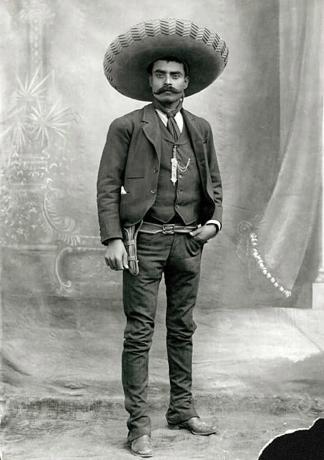
A mexican revolution was an armed resistance movement that took place in Mexico in the year 1910. It was initially led by Francisco I. Madero in opposition to the autocratic general Porfirio Diaz.
Regarded as one of the first great revolutions of the 20th century, dissidents from the government, peasants and indigenous people participate in the movement.
see more
Scientists use technology to unlock secrets in ancient Egyptian art…
Archaeologists discover stunning Bronze Age tombs in…
The insurrection was characterized by liberal ideologies, socialist and anarchist. The groups fought for agrarian reform characterized by the distribution of land, the nationalization of multinational companies and a regeneration of national politics.
For 30 years (between 1876 and 1911), Mexico went through a long dictatorial phase, under the command of military leader Porfírio Diaz.
Known as the “Porfirista dictatorship”, this period of Mexican history was marked by the distribution and unequal control of portions of land in the hands of a few (latifundio), in addition to almost non-existent freedom democratic.
The dictator used dubious methods, such as electoral fraud (especially during the 1910 elections) and corruption to remain in power.
In the midst of this, the Mexican population found itself in a worrying situation. To give you an idea, at the time, almost 70% of people did not know how to read or write. Associated with this, the latent economic crisis further increased revolutionary moods.
With the enactment of the Lei dos Baldios (1893 – 1902), the government was allowed the right to take the land of indigenous properties and pass them on to landowners, most of them investors from other countries.
The entry of European and North American capital into the country took place to the detriment of the decadence and increase in the difficulties of the Mexican population who, dissatisfied, sought the departure of Porfírio Diaz from the government.
Pressured by the poor class, people from the political elite and even church representatives, the dictator resigned in 1910. Thus, with the acceptance and help of the most popular classes, led by Emiliano Zapata and Pancho Villa, Francisco Madero took power in 1911.
The main proposals presented by the new ruler included the fair redistribution of landholdings and the reformulation of agrarian and political laws.
With Madero in power, the Mexican people expected an improvement in the dire situation in which they found themselves. However, the situation remained the same, and even worsened in some respects.
Dissatisfied with the new government, peasant leaders Emiliano Zapata and Pancho Villa started a revolution that would remove Francisco Madero from power, as he did not actually fulfill his promises of social improvements and reforms agrarian.
Madero's successors also suffered retaliation from the revolutionaries. However, in the year 1917, Venustiano Carranza assumes the position of president of Mexico.
To put an end to the exacerbated revolutionary feeling once and for all, the leader enlisted the help of U.S to plot the death of the rebels Zapata and Villa, in 1919 and 1923 respectively. Thus, the movement lost strength and opened the doors to foreign investment in the country.

Between the consequences of the Mexican Revolution, we can highlight the approval of the Constitution of Mexico in 1917, during the mandate of Venustiano Carranza.
The document redefined the social structure of the country. One of the positive points was the expropriation laws for large estates, in addition to the recognition of indigenous rights.
There was also the creation of the minimum wage and the reduction of the working day to 8 hours a day. The separation between State and Church was also established, putting an end to the co-participation of the religious institution in government decision-making.
Despite limited changes, the Mexican Revolution brought more hope and development to the Mexican nation. The agrarian reforms were in fact not fully implemented and the situation of the Indians is still neglected today.
Added to this was the difficulty of competing with foreign industries that produced their products on a large scale. Indebtedness and the struggle for land also profoundly marked the political, social and economic history of the country.
The figure of the revolutionary Emiliano Zapata Salaza is a symbol of struggle in Mexico. His heroic deeds marked a generation that yearned for changes and improvements in the quality of life.
In addition to the Mexican Revolution, Zapata became the main leader of the Liberation Army of the South, commanding almost 30,000 men in disputes against the government.
Moved by anarchist positions, he was prevented from assuming power in the country in 1914.

However, modern movements linked to Zapata's ideals remain strong today. The so-called Zapatista National Liberation Army – EZLN gained notoriety on April 1, 1994, in an action against the city halls of several cities in the country.
You defended ideals consisted of the end of the marginalization of the indigenous person, the end of political corruption, in addition to the end of NAPHTHA – North American Free Trade Agreement.
Currently, the leader of Zapatismo is introduced as subcomandante Marcos. The figure of the leader is characterized by his always hooded face, revolutionary speeches inflamed on the internet, in addition to criticizing the current governments, using a mixture of humor, folklore and poetry.
See too:What was the French Revolution?


